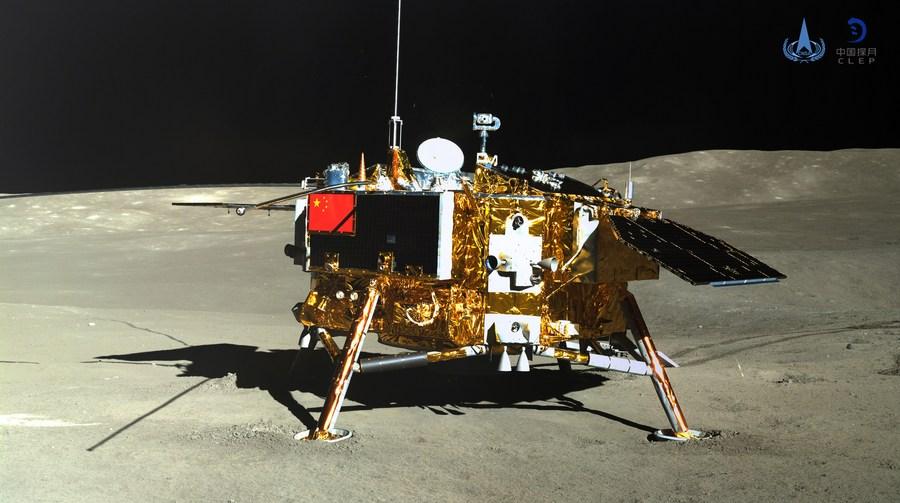Will lunar rover Jade Rabbit have company for the next Lantern Festival?
 0 Comment(s)
0 Comment(s) Print
Print E-mail Xinhua, February 6, 2023
E-mail Xinhua, February 6, 2023

Photo taken by the rover Yutu-2 (Jade Rabbit-2) on Jan. 11, 2019 shows the lander of the Chang'e-4 probe. [Photo/Xinhua]
Yutu-2, China's operating lunar rover, ignites people's fantasies of the moon on a special day, the Lantern Festival of the Year of the Rabbit.
The festival this year falls on Sunday, the 15th day of the first month of the Chinese lunar calendar when a full moon appears.
As the closest celestial body to the Earth, the moon was the first stop for mankind to start the "interstellar era." From lunar probes, unmanned lunar vehicles to manned landing on the moon, human exploration of the moon has never stopped.
On the surface of the moon covered with large and small impact craters, a shallow track on the lunar soil extend far away -- this is the image of the lunar surface recently sent back by China's Yutu-2 lunar rover. The Chang'e-4 probe, which carried Yutu-2 to the moon, is the first human probe to achieve a soft landing on the dark side of the moon.
Yutu-2 is also the only lunar rover still in service on the moon. In operation for over four years, it has travelled nearly 1,500 meters, and released more than 940.1 gigabytes of scientific data.
A lunar rover is a probe vehicle that can move on the surface of the moon. In the 1970s, the Soviet Union and the United States respectively sent lunar rovers to land on the moon. The world's first unmanned lunar rover was the Lunokhod 1 launched by the Soviet Union. It landed in the Mare Imbrium, also called Sea of Rains, in November 1970 and worked there for about 10 months. The Soviet Union then sent the unmanned Lunokhod 2 to the Sea of Tranquility area on the moon in January 1973, and it was damaged after working for about four months.
The other three lunar rovers launched during this period were the manned lunar rovers carried by the American Apollo spacecraft 15, 16 and 17. They were used as vehicles in the early 1970s for astronauts to inspect the lunar surface, and are currently incapacitated.
Only two lunar rovers have successfully landed on the moon since then, both from China: the Yutu which landed in 2013 and the Yutu-2 in 2019.
Yutu, or Jade Rabbit, is known as the pet of Lunar Goddess Chang'e in Chinese mythology. The rabbit's common association with Earth's only natural satellite led China to name its first moon rover "Yutu."
Now, Yutu-2 is the only lunar rover in service, silently exploring the secrets of the far side of the moon among the bare rocks and craters.
China will fully promote the fourth stage of the lunar exploration program in 2023, including Chang'e-6, Chang'e-7 and Chang'e-8, said Wu Weiren, chief designer of China's lunar exploration program and academician of the Chinese Academy of Engineering.
Chang'e-6 is set to "collect samples from the far side of the moon and bring them back to Earth, aiming to achieve a goal of 2,000 grams," he said.
Chang'e-7 is going to land on the moon's South Pole and has a flyover to search for water, and Chang'e-8 to be launched around 2028 will form the basis of a scientific research station at the moon's South Pole with Chang'e-7, said Wu, adding that the station will include a lunar orbiter, a lander, a rover, a flying vehicle, and multiple scientific instruments.
The missions are, on the one hand, to search for water, Wu said, and on the other hand, to explore the state of the moon's South Pole, as well as its topography, the material composition of the environment, among others.
"Jade Rabbit" may not feel lonely this year, as another "white rabbit" will come to the moon to accompany it soon. The lander of the HAKUTO-R Mission 1, Japanese for white rabbit, of the Japanese company ispace is expected to make a soft landing in the Atlas Crater of the lunar surface in April.
Danuri, South Korea's first-ever lunar orbiter, launched aboard a SpaceX Falcon 9 rocket in early August last year and arrived in lunar orbit in December. Recently, it sent back images of the moon's surface.
Lunar Flashlight, the U.S. space agency NASA's small satellite will enter into orbit around the moon this year. It will use near-infrared lasers and an onboard spectrometer to map ice in permanently shadowed regions near the Moon's South Pole. Besides, NASA is working hard to develop the Volatiles Investigating Polar Exploration Rover, or VIPER. This golf-cart-size mobile robot will land at the South Pole of the Moon in 2024 on a 100-day mission in search of water and ice.
Several other countries are also pushing ahead with lunar exploration missions this year. Chandrayaan-3, India's third lunar exploration mission, is scheduled to be launched this year after several delays. The country aims to put a lander and rover in the highlands near the South Pole of the Moon.
Russia also plans to launch its Luna-25 moon probe this year, whose main tasks include testing soft landing technologies and conducting contact studies of the lunar South Pole.
These missions are stellar examples of human intelligence and curiosity, working together to reveal the secrets of the moon.





